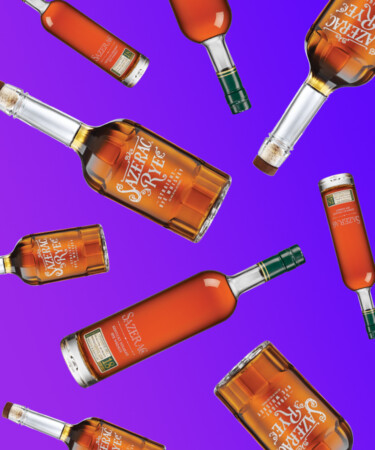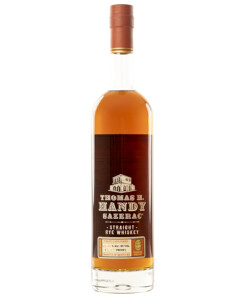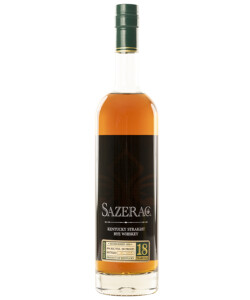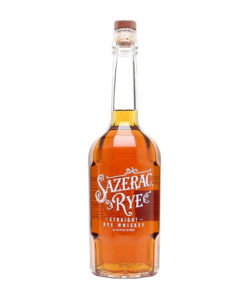While widely recognized as the name of a classic American cocktail, the Sazerac brand’s history dates back much further than the cocktail’s 1901 trademark. Before Sazerac was a multinational spirits conglomerate and before it received its own eponymous cocktail, Sazerac got its start producing Cognac as early as the 1630s. Once the spirit made its way across the Atlantic, it was an instant hit in New Orleans coffee houses. The Sazerac House was one of the most popular spots in the city, and by the latter half of the 1800s, the Sazerac cocktail was born — a delightful combination of rye whiskey, Demerara syrup, absinthe, and Peychaud’s bitters.
Made today at the Buffalo Trace Distillery, which is owned by the Sazerac Company, Sazerac Rye offers aromas of vanilla and anise, with subtle notes of banana and spice on a smooth finish. While Sazerac’s trademark rye is not marketed with an exact age statement, estimates place it at around 4 to 6 years old. Now that you know the basics, here are nine more things you should know about Sazerac Rye.
Sazerac’s roots are in the Cognac business.
Prior to producing rye whiskey, the Sazerac family found its start producing Cognac in France, establishing a vineyard and distillery in 1630 to produce eaux de vie. A century and a half later, the family’s patriarch, Bernard Sazerac, purchased Logis de Forge, a French estate still standing today, to distill Sazerac de Forge et Fils Cognac, which became the original spirit used in the Sazerac cocktail two centuries later. In the early 1800s, the Cognac was shipped to the United States, arriving in New Orleans where it quickly became one of the most popular local spirits.
The Sazerac family produced cannons for the American Revolution.
Benjamin Franklin was one of the many representatives sent abroad during the American Revolution to secure aid from foreign nations, including France. In 1779, Louis Sazerac de Roches, a member of the Sazerac family, joined a team under the direction of Franklin himself to produce cannons for the American Revolution.
Sazerac was popularized in coffee houses.
In the 1800s, it was commonplace in New Orleans for saloons and bars to be veiled as coffee houses in an attempt to maintain an upstanding appearance on each street and to promote an air of charm. Among the many New Orleans coffee houses was the Sazerac House, which was opened in the early 1850s by proprietor Aaron Bird and financial backer Sewell Taylor, who was rumored to have been the owner of the coffee shop. The Sazerac house quickly took to featuring the eponymous distillates exclusively. With a prime location in the French Quarter, quality spirits, and a number of famous patrons, Sazerac was able to lay the foundations to become what is today one of the largest spirits companies in the United States.
Sazerac gave rise to one of the first American cocktails…
In 1834, while Sazerac was establishing itself in the New Orleans cocktail scene, Antoine Peychaud was creating what is today known as Peychaud’s bitters at his apothecary just down the street from Sazerac House. There, Peychaud began combining Sazerac’s Cognac with absinthe and his bitters — a foundational recipe that went on to become what is now known as the Sazerac cocktail. By 1857, Peychaud’s bitters had been put to use at the Sazerac House, which was the only place in New Orleans selling Sazerac de Forge et Fils Brandies. With its creation dating back to the early 1800s and its trademark arriving in 1901, the Sazerac is widely recognized as one of the oldest cocktails in America and is the official cocktail of its home state, Louisiana.
…But there is some debate surrounding the original cocktail’s ingredients.
Many drinks historians believe the spirit used in the Sazerac switched from Cognac to rye in 1885, when a phylloxera outbreak in Cognac caused a brandy shortage. In response, Sazerac pivoted to distilling rye, as grains needed to produce it were widely available in the United States, and bartenders subsequently replaced Cognac with the American whiskey in Sazerac cocktails. It has also been argued that the switch from Cognac to rye never happened, and that the cocktail was made with rye from its inception.
James Martin — director of the short film “The New Orleans Sazerac” — believes the drink very well may have always been made with American rye, never Cognac. He tells Tales of the Cocktail that the Sazerac has a “really funky history, because nobody really agrees on it, and different historians believe different things.” His personal belief is that perhaps there was never an evolution away from Cognac and that the cocktail was always made with rye.
If younger whiskies aren’t your style, Sazerac also offers two older variations.
While Sazerac’s original rye is the brand’s most commonly consumed product, it also has two older distillates under its umbrella — Sazerac 18-Year-Old and Thomas H. Handy Sazerac. Sazerac 18-Year-Old is one of the most sought-after whiskies in the world, bringing forward aromas of allspice, cinnamon, and dried fruit with burnt caramel and dried herbs on the palate. Aged for six years and four months, Thomas H. Handy is named after the owner of Sazerac House from 1869 to 1893, the first known individual to use rye whiskey in the Sazerac. The rye is unfiltered and bottled directly from the barrel. It brings forward a spicy aroma and notes of toffee, fig cake, and cinnamon on a long and warm finish.
Sazerac 18-Year-Old and Thomas H. Handy Sazerac are included in the Buffalo Trace Antique Collection.
Released only once a year, Sazerac 18-Year-Old and Thomas H. Handy Sazerac are two highly coveted whiskeys among whiskey aficionados — bottles of the former can retail for up to $2,500; the latter reaching prices over $800. As such, the rare bottlings are members of Buffalo Trace’s Antique Collection, which is released every fall and includes a collection of five of the distillery’s allocated releases. Within the collection, one can find Sazerac 18-Year-Old, Thomas H. Handy, George T. Stagg, William Larue Weller, and Eagle Rare 17 Year Old. In total, the annual collection ranges in value from $2,400 to over $12,000.
Sazerac’s exact mash bill will forever remain under tight wraps.
Buffalo Trace prides itself on the confidential nature of its mash bills. It’s likely that this confidentiality — along with the production of high-quality spirits, of course — is precisely what has garnered the distillery such a cult-like following. While Sazerac’s exact mash bill will be unknown to the general public for the foreseeable future, the whiskey must contain at least 51 percent rye and has been rumored to contain 39 percent corn and 10 percent malted barley.
Sazerac Rye is nicknamed ‘Baby Saz.’
The most widely available, and thus most consumed, Sazerac offering is its original rye with no age statement. Sharing the same name, mash bill, and proof as Sazerac 18-Year-Old and Thomas H. Handy Sazerac — both of which are extremely valued among whiskey lovers — Baby Saz is a colloquial name for the youngest sibling in the Sazerac family.



